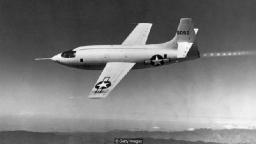The Spitfires that nearly broke the sound barrier.

- By Stephen Dowling
6 May 2016

While Yeager’s name may be the one celebrated in the record books, there were other pilots who got close – very, very close – to this challenging aerodynamic barrier in the years before. Some even lived to tell the tale. What is all the more impressive is the aircraft they flew were physically incapable of reaching the speed of sound. Just getting close could cause planes to break apart.
A handful of flights in Supermarine Spitfires – the single-seat fighter plane that helped win the Battle of Britain – were crucial in helping scientists understand the forces that would have to be overcome if a plane was able to fly faster than sound.
The Spitfire entered service just before World War Two, the brainchild of designer RJ Mitchell.
Later models of the Spitfire could fly well over 400mph in level flight, thanks to their powerful Rolls-Royce Merlin engine and the four-bladed propeller that helped generate extra thrust. Photo reconnaissance versions were even faster, flying without the dragging weight of machines guns or ammunition.
The plane’s superlative performance also made it a natural for test flights, especially for high-speed research. It was on these flights that some Spitfire pilots took the aircraft into previously uncharted territory – encountering the strange aerodynamic forces that occur when the sound barrier is within reach.
According to famed test pilot Eric ‘Winkle’ Brown's book Wings on My Sleeve, the high-speed trials began in late 1943. During the programme, Squadron Leader J R Tobin took a Mark XI Spitfire into a 45-degree dive; the plane reached a top speed of 606mph (975km/h), or Mach 0.89 (Mach 1 being the technical term for the speed of sound). It was the fastest speed a Spitfire had ever flown – or at least the fastest that a pilot had lived to tell the tale. But a far more dramatic flight was soon to take place.
In April 1944, Squadron Leader Anthony F Martindale, put the exact same Mark XI Spitfire into a dive. This time, the reduction gear designed to limit its speed failed. The propeller ripped off and the diving aircraft reached more than 620mph (1,000km/h) – Mach 0.92 – as it plunged towards the ground.

This warping would have been caused by the airflow over the wing as the plane picked up speed, explains Rod Irvine, the Royal Aeronautical Society’s aerodynamics group chairman. “When you start approaching Mach 0.85 or 0.95, what happens is you get this subsonic flow over the wing, and it starts to accelerate beyond the sound barrier,” he says. “It starts to flick around all over the place, and it feels like the aircraft is starting to shake itself to bits because you get this fundamental change in the aerodynamics.” Irvine says this problem remains today – airliners such as the Airbus A380 will travel as fast as they can without causing the air flowing over the wings to reach supersonic speed, which can create vibrations and buffeting.
Planes like the Spitfire had another big problem – the propeller itself. Older aircraft had a propeller that was directly connected to the engine – more power meant the propellers would spin faster and faster. Even with a plane travelling under 300mph (480km/h), the air travelling over these fast-spinning blades could reach supersonic speeds. The shock waves formed from this air travelling so fast over the propeller blades then added drag, buffeting and noise.
Jeremy Kinney, a curator at the Smithsonian Air and Space Museum in Washington DC, says the Spitfire’s designer, RJ Mitchell, had understood some of the issues around propellers from designing racing airplanes in the early 1920s.
“Say you’re standing under one of those racing planes at an air racing event at Cowes on the Isle of Wight in 1923,” says Kinney, “you’d hear this banging and clanking as the aircraft went overhead. That’s the tips of the propellers going supersonic.” Mitchell and his contemporaries realised simply connecting a propeller so it span faster and faster wouldn’t necessarily help an aircraft go faster and faster. Variable pitch propellers – where the propeller would automatically match the RPM of the engine – were much more efficient and helped planes like the Spitfire fly much faster.
But only so fast, says Kinney. “The combination of the piston engine and the propeller are a kind of symbolic limitation of ever-increasing speed,” he says. “And it builds the case for how monumental the turbojet revolution was. You can only get a piston engine to do so many revolutions per minute.
“There was this paradigm, at least for the first half of the 20th Century, that planes had to go higher, faster and further. The work required to make a propeller that could work through the supersonic regime was just too much,” says Kinney. “And why try, when the jet engine suddenly gives you that capability.”
Those high-speed dives in Spitfires – and other Allied fighter planes like the American P-51 Mustang and P-47 Thunderbolt – helped researchers glimpse the kind of challenges supersonic flight would bring. It led to the development of a different aircraft shape, one that could deal with the shockwaves created on the way to the sound barrier. A pointed nose, smaller wings, and a smooth fuselage that limited the effect of the shockwaves. A lot like Yeager’s Bell X-1, for example.
http://www.bbc.com/future/story/20160505-the-spitfires-that-nearly-broke-the-sound-barrier



Martindale was saved by simple physics. With the heavy propellers wrenched off, the aircraft was now tail-heavy, and this change in the centre of gravity forced it to climb up from the dive at great speed. Martindale was knocked unconscious from the stress of the climb, and woke to find his aircraft flying at 40,000ft (13 kilometres). Somehow he managed to glide the aircraft back to his base, and emerged unscathed. The stress of the plane’s dive had bent the wings, giving them a slightly swept shape – the kind of shape that would eventually help other aircraft travel through the sound barrier.
You wake up with your plane at 40,000ft, with no propellers and your wings twisted...and you still manage to glide back to base? THAT is cool under pressure!
Very interesting lesson from the history of heavier than air flight . I didn't know that about the variable pitch propeller .
They were introduced around 1917, standardized around 1928.
Fascinating post, Randy.
I recall a movie I watched years ago about the experimental attempts to reach and cross the speed of sound. The only word from it I recall is "buffeting, buffeting..." I cannot remember the name of the movie. I'll bet Nowhere-man knows it.
It was a David Lean movie (UK) from 1952 called "The Sound Barrier" in the US and "Breaking the Sound Barrier" in the UK.
When it was screened Chuck Yeager attended the premier and stated that if they actually did what they claimed they did in the movie to break the sound barrier, they would have killed all the pilots. (Yeager was the first to "officially" break the SB in 1947 in the rocket powers Bell X-1. Officially meaning they had the certification people present when he did it, on the third flight of the X-1 he actually recorded a flight at 1.01 mach two days earlier this wasn't reported as his mach meter didn't show it but the data recorders did. The data wasn't analyzed for four months until after the series of flights was over)
I'm not surprised at what Chuck Yaeger said about the pilots being killed if they did what they did in the movie. I recall in the movie that when they tried to pull the nose up they pulled the stick towards themselves which logically one would do and it didn't work, but the nose pulled up when the stick was pushed forward. At least that's what stopped the buffeting.
I just marvel at the courage it took to try it.
I'm in awe of these men that leaped into a machine and tried to break the sound barrier... There is a movie, for schools, called "High Speed Flight", from NASA. Really good about explaining the problems they had to overcome, as well as showing actual footage of Yeager, Crossfield, etc. I used to teach aviation, so that was a favorite movie to request...
Unless I got a notice with the movie: "Ooops! The movie you requested is unavailable, so we have selected a film in keeping with your request in subject matter and run time." It was usually, "Lights, Camera, Lettuce!"
Lol!